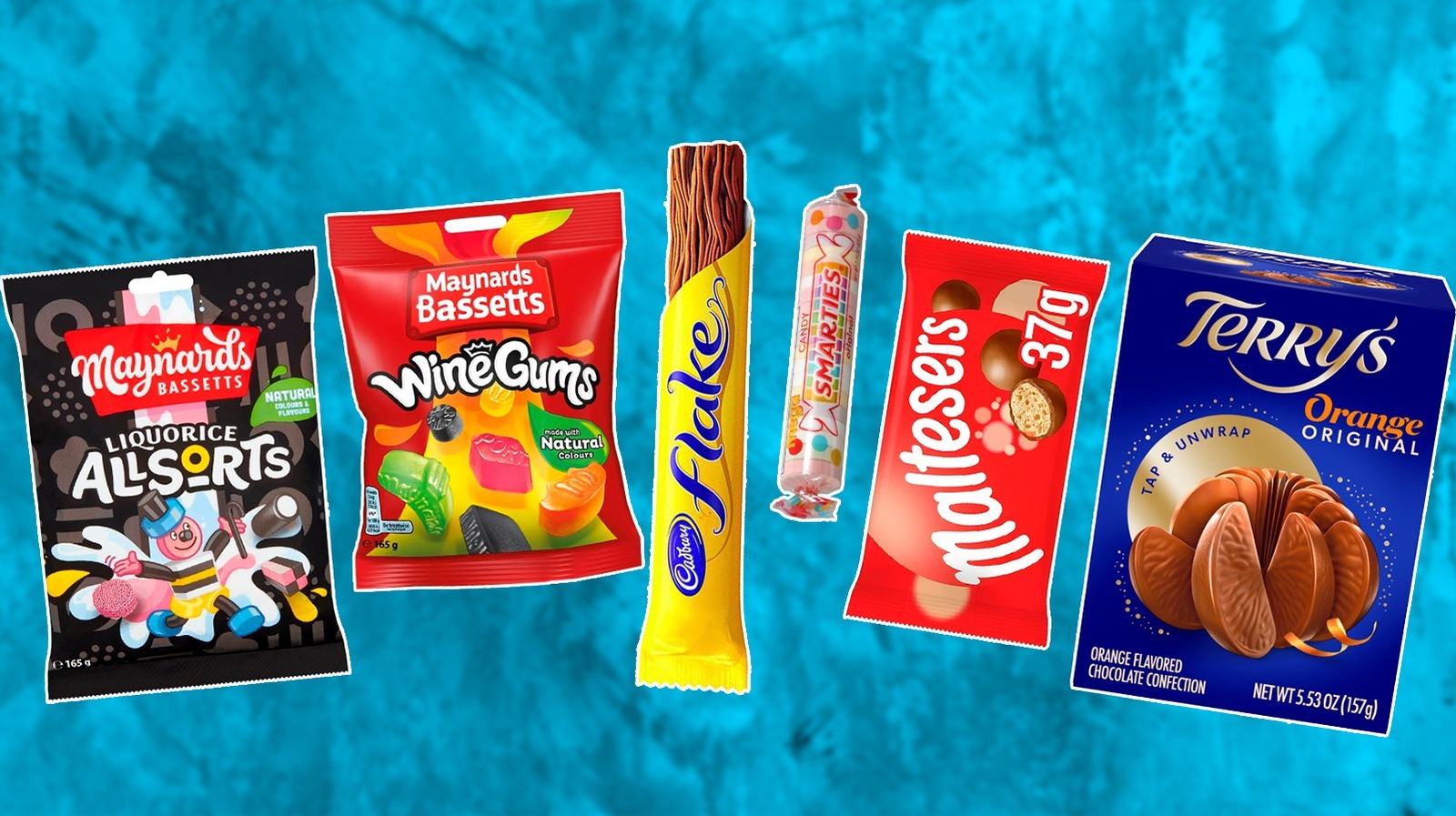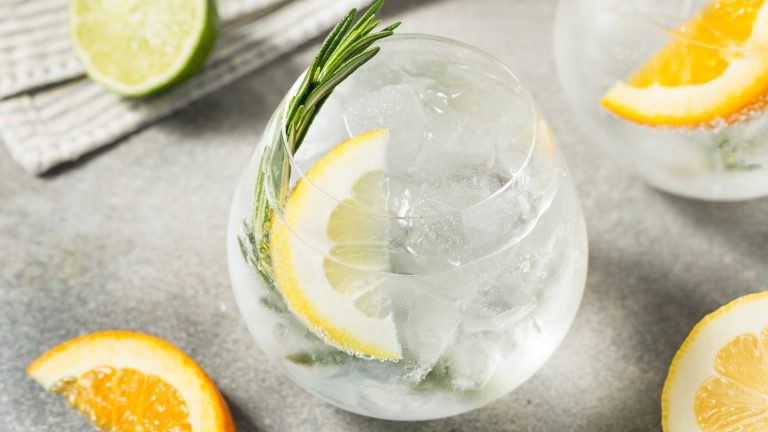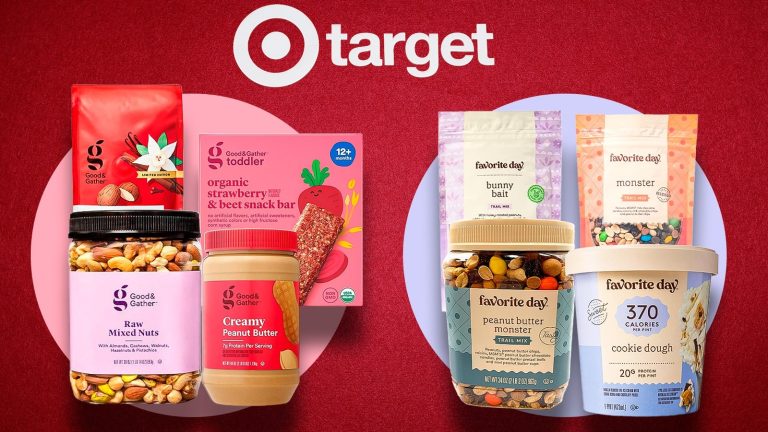If you have ever visited the UK and popped into the store for a quick bar of candy, you may have been mystified by the selection in front of you. With Jelly Babies, Creme Eggs, and Liquorice Allsorts all on offer, it can be hard to work out what on earth is contained in each packet, and what to look for if you just want a piece of chocolate.
While some specialty stores in the U.S. sell British candy, the majority of us are unfamiliar with British sweets, and the nostalgic stories that accompany them. Are Wine Gums alcoholic? Why do their Smarties look nothing like ours? And how on earth are you supposed to break into a Chocolate Orange? All of these questions and more will be answered as we explore the wonders of British confectionery in all its glory. So grab a cuppa and let’s take a look at the 15 British candies you need to try at least once.
Cadbury Flake
If you’ve always wanted to eat a chocolate bar that crumbles into a thousand beautiful pieces before you’ve even got it to your mouth, then you must try a Cadbury Flake. One of the most iconic chocolate adverts in the early ’90s featured a woman seductively eating a Flake in the bathtub, which many viewers assumed was to represent the luxurious, silky nature of the bar. In reality, she was likely trying to avoid cleaning up the crumbly mess afterward. But this is the fun of eating a Flake — trying to catch the shards before they fall to the ground is the ultimate chocolate challenge.
The Flake was invented by accident in 1920, when a chocolate machine broke and the cooled chocolate took the shape of thin sheets layered on top of each other. It went on to become one of Cadbury’s most iconic chocolate bars. Flakes are made of exactly the same chocolate as a solid bar such as Dairy Milk, but the crumbly texture is what makes it so iconic. The Twirl is essentially the same bar inside, but each finger is then coated in a solid thin layer of chocolate which makes it much more manageable, especially if you are on the move.
Liquorice Allsorts
Liquorice Allsorts are an almost inexplicable assortment of candy that sum up the eccentricities of British confectionery. Centered around the flavor of licorice — a taste that most people hate — Allsorts manage to be sweet enough to have captured the love of a whole nation.
Like the Flake, Liquorice Allsorts were a happy accident. After failing to sell a single licorice sweet to a wholesaler in 1899, a Bassett salesperson spilled the whole tray of samples on the floor, creating an assorted heap of candy that caught the wholesaler’s eye. Ever since, each item in a bag of Liquorice Allsorts consists of a strip of licorice surrounded by brightly coloured sweet fondant that helps offset the strong flavor of the herbal licorice. They take a variety of shapes from little wheels to the famous “sandwiches,” and even have their own mascot, Bertie Bassett, who was made entirely from the colorful candy pieces.
Aero
A chocolate bar that is packed full of tiny air holes may not seem very appealing — or good value for money — but once you’ve taken a bite of the smooth Aero bar, you will understand. The bubbles ensure that as soon as the chocolate hits your tongue, it disappears in a delicious wave of intense sweetness, making it the lowest effort candy you will ever eat.
Rowntrees introduced the original mint flavor Aero in 1935, and the milk chocolate version followed in the 1970s. Both remain favorites among British chocolate lovers and there are other versions, too, including caramel, hazelnut, and strawberry.
The success of Aero bars has led to bite-size versions known as Aero Bubbles becoming very popular since they were introduced in 2005. If you have the chance to get your hands on an Aero bar, you will discover why previous adverts claimed they were “irresistibubble.”
Maltesers
If you’re in the mood for a quick chocolate snack, but don’t have the appetite for your favorite candy bar, Maltesers are there to fill that gap. Famously known as being “the lighter way to enjoy chocolate,” they are crisp spheres of honeycomb coated in a smooth layer of chocolate, and they are as fun to eat as they are noisy.
Released in 1937 by Mars, they are one of Britain’s most iconic candies, and are sold in small pouches for individual snacking, as well as flat, roomy boxes for sharing. In fact, as a child (or an adult, let’s be honest) few things were more satisfying than shaking a wrapped present to hear the delightful rattling of Maltesers bouncing against each other.
The lightweight nature of Maltesers has given them a special place in British culture, as the feature of the famous Maltesers Straw Game — sophisticated name, we know. Variations include blowing a Malteser across the table using a straw, and transferring as many as you can from one bowl to another via a dramatic sucking motion. The candy has also been the subject of some refreshingly inclusive and honest adverts, including one featuring disabled actors relating funny stories, and another with a woman crunching on a Malteser to demonstrate the painful experience of breastfeeding a teething baby!
Tunnock’s Teacake
The Tunnock’s Teacake is not your regular candy bar, nor is it a posh biscuit for eating at a fancy afternoon tea. If you get a chance to try one, you absolutely should, but be sure to bring a napkin, as they are famously difficult to eat without making a glorious mess.
First created in 1956 in Uddingston, Scotland, Tunnock’s Teacakes are based on a light Italian meringue, set upon a crispy and slightly chewy base, and coated in a shell of smooth chocolate. The classic milk version comes wrapped in an incredible thin sheet of foil with the distinctive red and silver design, and the more recent dark chocolate version is silver and blue. An essential part of devouring a teacake is smoothing out the wrapper afterward to remove all of the wrinkles.
The etiquette issue with a Tunnock’s Teacake is that biting into the top of it causes the shell to crack and begin to collapse in on itself, which in turn leads to the mallow oozing out the sides. While some people try to avoid this by nibbling daintily along the biscuit at the bottom, if you want to enjoy the teacake as it was designed, it is better to embrace the delicious mess and clean up the aftermath later.
Wine Gums
Don’t get too excited if you come across a packet of Wine Gums in the candy aisle on your trip to Britain — these classic sweets are completely teetotal. Misleading, perhaps, but they remain an all-time favorite British candy, invoking nostalgic memories of sharing a family-size bag on a night at the movies.
Although many brands have used the name Wine Gums, Maynard’s version is the most famous and was originally released in 1909. The concept behind the name likely stems from the idea of them being a more sophisticated candy than many others on the market that were aimed at children. They certainly have a stronger flavor than most chewy candy and aren’t as sugary on the palate.
Compared to other chewy sweets such as gummy bears, wine gums have a firmer texture, meaning they take longer to chew than you may expect. This is one of wine gums’ distinctive qualities that help them stand out from generic chewy candy more than 100 years after they were released. They come in a variety of fruity flavors including orange, lemon, blackcurrant, and cherry, and many a family argument has broken out trying to ascertain which flavor is best — in case you’re wondering, it’s definitely orange!
Galaxy Caramel
When choosing a chocolate bar in the UK, one question usually rises above the rest: Cadbury or Galaxy? As two of the leading chocolate brands, they both produce quality chocolate, but the flavors and textures are not the same. Galaxy is known for being a smoother and sweeter than Cadbury, and the most indulgent and luxurious has to be the Galaxy Caramel.
Released in 1994, the bar is sectioned into six rectangular pieces, each of which is filled with a silky, golden elixir. The shell is made of sumptuous Galaxy chocolate — which actually beat Cadbury Dairy Milk in a blind taste test — and is just thin enough that it melts away on your tongue to reveal the gorgeous caramel encased within. The branding is as elegant as the chocolate bar itself, and opening the glossy wrapper will make your taste buds tingle with excitement. If you can get your hands on a bar, you will understand what all the fuss is about.
Boost
If you are in the mood for a subtle, refined candy bar, then a Cadbury Boost is not going to hit this spot. This chocolate bar is unapologetically bold, packed with caramel and chewy biscuit, it is definitely only for those with a sweet tooth.
Released in 1985 as a coconut Boost, there have been a number of variations throughout the years, including a peanut version, though the biscuit bar is the one that has stood the test of time. There was even an energy bar version in the early 2000s, which had guarana as an added ingredient. Guarana is a natural stimulant often used in caffeine-filled energy drinks, and the fact that these versions of Boost weren’t suitable for children, pregnant women, or professional athletes garnered plenty of criticism. The super-charged chocolate didn’t last long, leaving us with a regular candy bar that is still packed with energy, meaning you might need to take a run round the block to get your blood sugars back to normal levels afterward.
Fruit Pastilles
For a pack of sugary candy that is bursting with bright fruity flavors, Fruit Pastilles are the perfect choice. Chewy to the point of sticking to your teeth, with a sugar coating that provides a slight crunch first, they are the ultimate sweets to carry in your pockets for when you need a boost.
Created in 1881, they were Rowntree’s first confectionery product. They have various different names across the globe, including the magical sounding Wonka Fruit Pastilles in Australia.
They contain real fruit juice — though you could hardly call them a healthy snack — and the various colors represent five fruity flavors: lime, lemon, strawberry, orange, and blackcurrant. If you have fillings that aren’t as secure as they could be, it might be worth giving Fruit Pastilles a miss. Otherwise, buy a pack if you get the chance, and enjoy one of the delicious fruity discs whenever you have a sweet craving.
Terry’s Chocolate Orange
What could be better than a candy that requires a game to open up before you tuck in? The candy in question is not a bar at all, but a delicious citrus flavored sphere in the form of a Terry’s Chocolate Orange. Made up of 20 solid chocolate segments, the opening game involves whacking it on a solid surface just hard enough to break it beautifully into its individual segments, without cracking any of the pieces.
Terry’s sold the first chocolate orange in 1932 as a Christmas confectionery, but it was predated by the Chocolate Apple. A chocolate lemon was also on sale for a short while, but the success of the chocolate orange clearly signaled to the company which fruit to focus on. The main flavors now are milk chocolate and dark, but there have been occasional special editions, including mint, white chocolate, and exploding candy minis.
You may come across the chocolate orange in the U.S. at Christmas time, and they make excellent stocking fillers. Imagine the fun of the whole family sitting round whacking their chocolate spheres to see who can crack into it first — holiday bliss.
Cola bottles
If you love a real bottle of cola as a sweet treat, then you should give the gummy version a try, as these classic British sweets capture the sugary deliciousness of the real thing, but in miniature form. Shaped like a glass bottle of cola, cola bottles are one of the best-loved British candies, and are still very popular today.
Though you can buy packs of cola bottles on their own, the most famous place to come across them is as part of a pic ‘n’ mix. In Scotland, these go by the nostalgic name of 10p mixtures (or 20p, if you’re feeling fancy) and consist of a random assortment of penny sweets such as foam bananas, chocolate mice, and jelly fried eggs alongside the iconic cola bottles. Due to inflation, 10p mixtures probably cost a few pounds these days, but the bizarre selection of sugar-packed treats still remains.
Do cola bottles actually taste like Coca-Cola? Well, not really, but the flavor has become nostalgic enough that most Brits will insist they do. They are reminiscent enough of the flavor to keep us happy, and if you want to go even further, you can try out the “fizzy” version which are coated in even more sugar and have a fun sour note to them.
Fry’s Chocolate Cream
No list of British chocolate would be complete without mentioning Joseph Fry, since he is commonly credited with inventing the chocolate bar in 1847, and Fry’s Chocolate Cream is the oldest mass-produced chocolate bar still on the shelves. The classic packaging of the bar was exciting in itself — a silver foil wrapper encased in a paper sleeve, along the lines of the legendary Wonka bar from the movie version of Charlie and the Chocolate Factory. The packaging has given way to a more modern plastic wrap, but the luxurious chocolate and cream filling is as good as it ever was.
The bar consists of a thin shell of plain chocolate — rather than milk — and the centre is filled with a delicious smooth fondant. Peppermint and orange versions are also popular, and still available, but the original flavor holds a dear place in British hearts. Elegant, simple, and not overly sweet, Fry’s chocolate cream is a candy bar that will never fail to delight.
Smarties
If you’re thinking that Smarties are a candy you are already familiar with, there’s a good chance that’s not the case. The pastel-colored fizzy discs in the U.S. bear no resemblance to the British Smarties, which are a chocolate treat marketed mainly at children.
Consisting of hard chocolate discs coated in a colored sugar shell, Smarties bear the closest resemblance to M&Ms, though the chocolate flavor is distinctly different. Even long before the issue of plastic waste, Smarties were sold in a paper tube, often with a joke or puzzle written on the side, and a letter of the alphabet under the colorful plastic lid.
Originally brightly colored in a similar fashion to M&Ms, they are now a softer, more pastel tone due to the removal of artificial colors. This began in 2006 as a result of the controversy surrounding the blue Smartie, which has now returned colored with spirulina. Smarties are still as popular as ever with both kids and adults, now with a more natural hue.
Cadbury Creme Egg
Cadbury Creme Egg is a candy like no other. A thick chocolate shell filled with gooey yellow and white fondant, it is designed to resemble a real egg, and is very much for those with a sweet tooth. They are big sellers at Easter time, but can be bought year round in the U.K. and have spawned several egg-themed spin offs. Miniature creme eggs, caramel creme eggs, and a creme egg bar have all hit the shelves over the years, as fans scramble to get their hands on the delicious fondant.
The Creme Egg was known for a series of famous TV adverts that spanned four decades from the 1970s, featuring the slogan, “How do you eat yours?” From nibbling round the chocolate shell to biting off the top and scooping out the fondant, everyone has their favorite way to devour this classic treat.
Jelly Babies
Jelly Babies are one of the cutest British candies around, and they are extremely popular due to their fun bright colors and sweet fruity flavors. Originally named Peace Babies by Bassets to mark the end of the First World War, they became known as Jelly Babies during the 1950s and have remained popular ever since.
Many people don’t realize that as well as distinct colors and flavors, each Jelly baby has its own name, too. Brilliant, Bubbles, Boofuls, Big Heart, Bumper, and Baby Bonny cover a rainbow of colors and fruity flavors, including the rarely-seen in the US blackcurrant flavor. The texture of Jelly Babies is different from the hard, chewy sweets such as gummy bears or Haribo. Instead, they are soft inside, with a tiny crack as you bite into them, and a light dusting of sugar that gives them their signature look.





